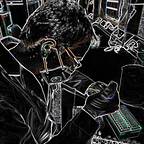Indian Rāgas 101: Detour — analytical methods
In a discussion of music, we can never leave maths too far behind. Which means, we need techniques to analyse — and visualise — sound.
For electronic music, this is easy. Lossless files (WAV) are stored as a sequence of numbers, which reflect the very waveform. For example, when I say ‘Sa’ at my microphone and save it as a WAV file, it gets stored like this
import matplotlib.pyplot as plt
from scipy.fftpack import fft
from scipy.io import wavfile
bitrate, data = wavfile.read('sa.wav') # load the data
print(data)# Output
array([[184, 0],
[138, 0],
[186, 0],
...,
[730, -1],
[673, 0],
[710, 0]], dtype=int16)
When plotted directly, this data gives the bare waveform
a = data.T[0] # Selecting the first channel, remember these days all audio is stereo, i.e. two separate channels
plt.plot(a{:1000]) # Plotting the first 1000 values for easy visualisationAs you can see, I am not producing pure tone (actually, far from it). I am producing a random mix of frquencies. To break it down, we will use a Fast Fourier Transform (Code snippet from user eusoubrasileiro at https://stackoverflow.com/questions/23377665/python-scipy-fft-wav-files)
import matplotlib.pyplot as plt
from scipy.fftpack import fft
from scipy.io import wavfile
bitrate, data = wavfile.read('sa.wav')
data_fft = fft(data.T[0])
length = int(len(data_fft)/2)
plt.xlabel("Frequency")
plt.ylabel("Amplitude")
plt.plot(abs(data_fft[:(length-1)]),'r')
plt.show()My ‘Sa’ is a lot many frequencies. most prominently those between 1000–2000 Hz. This is not very useful: let’s try it out with a piano.
As expected, the piano produces a much cleaner graph (pardon the ambient noise at my home, which are showing up as the low frequencies). The Fourier transform produces nice frequency graphs, which will be handy for our purpose.
Visualising all at once
Any sound, in effect, is a set of frequencies, having certain amplitudes, which change with time. We can, theoretically, make a 3 dimensional plot of all three variables. (Wavosaur has built in 3D spectrograms: https://www.wavosaur.com/download.php).
Alternatively we can represent the 3rd dimension with intensities of color (brighter = louder) and convert any sound (of a certain duration) into an image!
Try it out at https://auditoryneuroscience.com/acoustics/spectrogram.
